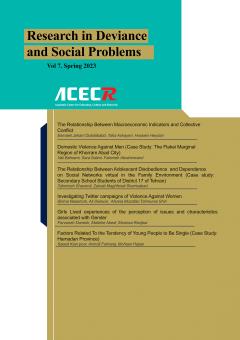-
-
-
Open Access Article
1 - The sociologically study of the Cohabitation in Tehran City
Masoumeh Motlaq mahdieh ghoreishiThe purpose of this research is the sociologically study of cohabitation phenomenon in Tehran city. In recent years, family institution has experienced many changes which one of them is known cohabitation as a new emerging style of common life. According to nature and s MoreThe purpose of this research is the sociologically study of cohabitation phenomenon in Tehran city. In recent years, family institution has experienced many changes which one of them is known cohabitation as a new emerging style of common life. According to nature and subject qualitative research is considered and a purposeful method of sampling and snowball sampling are applied for achieving to theoretical saturation; therefore, in this research 60 person of that experienced cohabitation in 17th Area of Tehran were interviewed. The analyzing of data is based on grounded theory method. The impact factors in the phenomenon of cohabitation can be classified in three categories. The findings show that the following factors have the most impact, including; economic factors (unemployment, lack of job security, costs of marriage) legal factors (the responsibility of marriage, unfair contract between partners and so on) social factors (social changes, generation oppositions, sexual abnormalities and the increasing of conflicts in the society). Manuscript profile -
Open Access Article
2 - Changes in the Family in Contemporary Iran Emphasis on Marriage and Divorce
shahla kazemipuorThe institution of the family in Iran has faced important changes during the last few decades, such as a transition from extended family to a nuclear family, an increase in marriage age, a decrease in the marriage rate, an increase in absolute celibacy, a change in crit MoreThe institution of the family in Iran has faced important changes during the last few decades, such as a transition from extended family to a nuclear family, an increase in marriage age, a decrease in the marriage rate, an increase in absolute celibacy, a change in criteria for choosing a spouse and increase in divorce. The purpose of this study is to present a picture of the evolution of the family and introduce theoretical approaches with an emphasis on the state of marriage and divorce. To explain the evolution of the family, three theoretical approaches have been used, "modernization theory", "second demographic transition theory" and "postmodern theory". In this study, two methods of "documentary" and "secondary analysis" were used. First, the topics related to the background, literature and research theories have been used from available scientific sources. And then, by referring to the data of the results of the censuses, the civil registration organization and the national survey report, the developments of marriage and divorce have been explained. The results showed that during the last four decades, the share of extended families has decreased and the net marriage rate has decreased, the average age of marriage and divorce rates have increased, and the criteria and methods of choosing a spouse and the attitude towards divorce have changed from traditional dimensions to modern ones. To make policies to increase the marriage rate, reduce the age of marriage and reduce the divorce rate, because the causes of most of the changes that have emerged are socio-cultural, it is suggested that instead of providing loans and facilities for marriage or issuing a directive to reduce divorce,special measures should be takenin the field of cultural issues and to change the lifestyle components in the country. Manuscript profile
List of Articles Modernization
-
The rights to this website are owned by the Raimag Press Management System.
Copyright © 2017-2024

